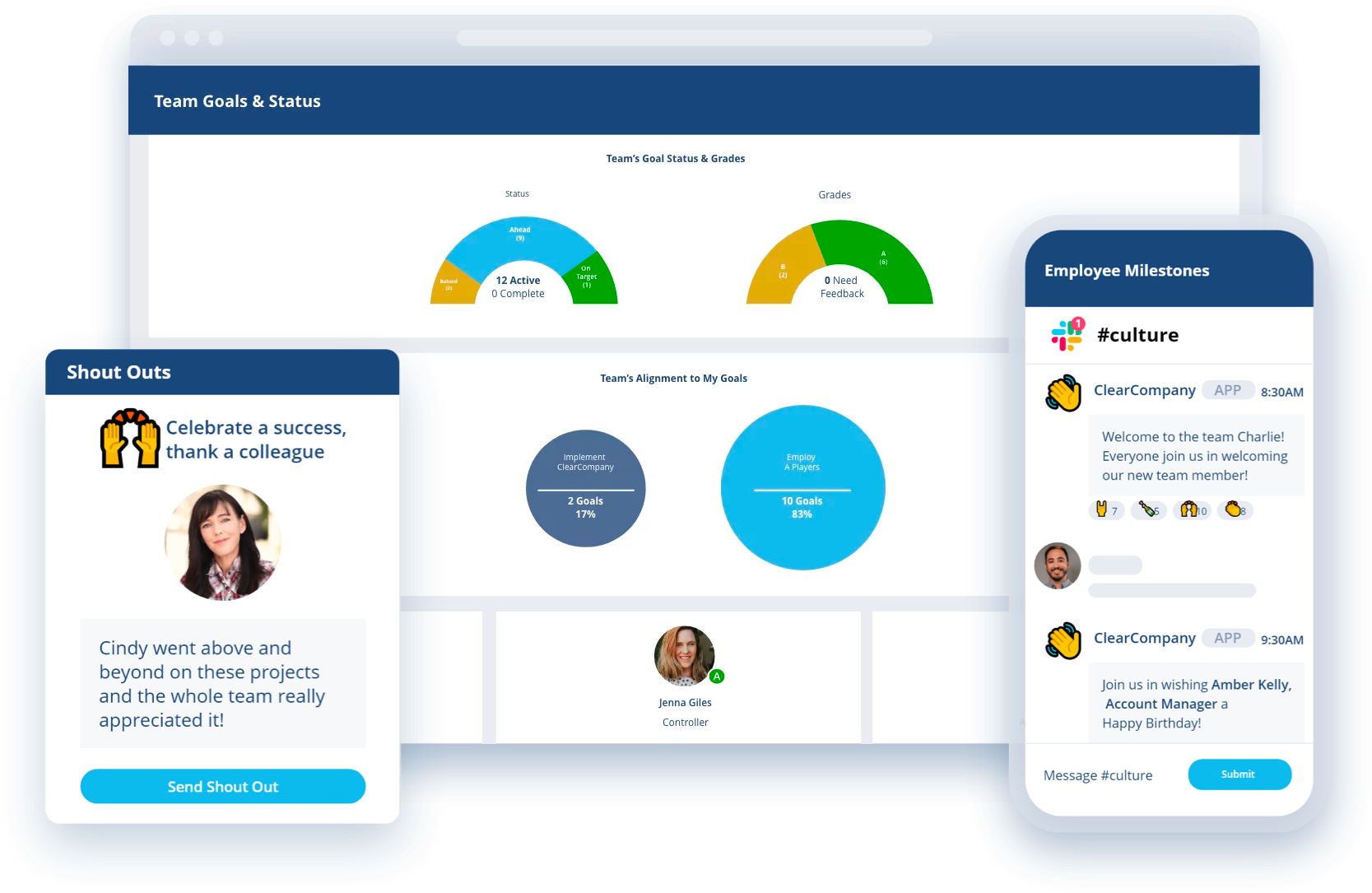This post about employee goal alignment and engagement was originally published in December 2013. It was updated with new information in January 2024.
It’s time to improve employee engagement in the U.S. Only 31% of employees are thriving, according to Gallup research, down from 33% in 2021. Nearly half — 47% — are considering or actively searching for a new job. 17% of employees are actively disengaged, and 52% are quiet quitting.
When employees aren’t engaged, they’re not as productive and more prone to making mistakes. While quiet quitters are more or less checked out at work, disengaged employees are more actively destructive. Labeled “disruptors” by McKinsey, these employees act out their unhappiness and drain the entire team’s morale. The lack of motivation also means less innovation, which equates to losses in customer satisfaction and loyalty and, ultimately, decreased profits.
From all this research, there are a few takeaways for business leaders and human resources teams:
- Quiet quitters are far more common than thriving or actively disengaged employees. Working to engage these employees can have the biggest payoff for businesses.
- Engaging employees is about more than just job satisfaction. Key factors for engagement include feeling supported and understanding how their work contributes to business success.
- Managers are responsible for 70% of their team’s engagement —but many of them are quiet quitting, too. Supporting managers with coaching and training can help improve engagement for them and their teams.
Luckily, there are many proven strategies for working against this trend so you can engage and retain your employees. One way is through goal alignment. Aligning employees’ goals with team and organizational goals increases transparency and creates a sense of connection to their work.
Let’s look at some of the factors contributing to the engagement slump and how to use goal alignment to improve it.
What’s Causing the Employee Engagement Decline?
Lots of factors come into play in the conversation around declining engagement at work. Most employees in the U.S. —52% — say they regularly feel high levels of stress. Many report feeling disconnected and unmotivated. But why?
Much of the problem is because of a lack of communication and support:
- Only 47% of employees know what they’re supposed to accomplish at work.
- Only 37% have the materials and equipment needed to do their jobs.
- 68% don’t have anyone encouraging their professional development.
- 70% of employees have not received any recognition in the past week.
- 70% say no one has spoken with them about their progress at work in the past six months.
- 67% of employees don’t have access to learning or growth opportunities.
The data clearly shows that most employees don’t feel seen, heard, or encouraged —they don’t feel valued by their company. It’s hardly shocking that so many people are disengaged or quitting.
So, how can your HR team help your employees understand that their work and perspective are essential? One effective way to do so is with goal alignment.
What Is Goal Alignment?
Goal alignment is the process of setting individual and team goals that coordinate with business goals and strategy. Aligned goals are connected to the broader mission and vision of the company and enable a unified effort toward shared objectives.
An aligned employee goal-setting strategy means every person can better understand how their work plays a part in the company's success. It’s the “why” behind their work, and it helps everyone see how their colleagues are contributing, too. Aligning goals can even improve productivity by 22 percent.
4 Ways Goal Alignment Boosts Engagement
Let’s look at some ways aligning goals can help your company boost engagement.
1. Clarifies Expectations
Are your employees setting goals regularly? If they do, do managers help them understand why they’re working toward those goals? More than half of employees are unsure of what’s expected of them at work, which indicates that their goals aren’t clear or they don’t have goals at all.
You can set SMART goals to help combat this uncertainty. SMART goals are:
- Specific
- Measurable
- Achievable
- Relevant
- Timely
With SMART goals, you answer a majority of the questions your employees might have about what’s expected of them at work. Here are a few of the questions you proactively answer when you use this method:
- Specific: What am I expected to achieve this month, quarter, and/or year?
- Measurable: How will I stay on track, and how do I know if I’ve achieved the goal?
- Achievable: Can I feasibly reach this goal?
- Relevant: Are my goals aligned with personal, team, and/or business objectives?
- Timely: How long do I have to accomplish this goal?
Understanding both what they need to do and what their colleagues are expected to do helps motivate your people to achieve their goals.
Disengagement Doesn’t Have to Be Permanent
Disengagement is treatable, says Leigh Thompson, professor of management and organizations at Northwestern’s Kellogg School of Management and work relationships expert. “Most of us want to be engaged because it’s just more fun to be engaged. If I’m going to be at work, why not be engaged?”
via KelloggInsight
2. Provides a Performance Framework
When you set aligned goals, you’re creating a performance management framework, which enables you to evaluate employee performance accurately and fairly and provide valuable feedback. As the basis of this framework, aligned goals help you and your managers understand what success looks like for every team member. From there, you can track how your people are doing, provide feedback and support as it’s needed, and adjust goals as they progress.
Then, during performance review season, you can use those goals to give additional feedback, understand employees’ strengths and weaknesses, and set new goals going forward. When employees get regular feedback and have the chance to exercise and develop their strengths, they’re far more likely to feel connected to and engaged in their work.
3. Strengthens Relationships
A majority of employees don’t feel seen or heard at work, sapping their engagement. Some of the main factors contributing to that feeling include not having supporters or friends at work and a lack of communication, especially with managers. Lots of people don’t feel their efforts are being recognized or their opinions considered, and they don’t have a line of sight into what their colleagues are doing.
Goal alignment helps build new relationships and strengthen tenuous ones. It helps managers understand what employees will need to reach those goals and give more useful feedback. Among colleagues, aligning goals shows what each person and team is doing to achieve success. It helps everyone recognize employee achievements across the organization.
4. Improves the Employee Experience
If you didn’t believe it before, you should now —setting aligned goals improves the employee experience. Your employees will know exactly what to do to be impactful members of their teams and move the needle on company objectives. They’ll get more feedback and support from their managers and can give and receive kudos to their coworkers.
Goals set the tone for the entire employee experience. They motivate great work and enable collaboration, facilitating the connection and trust that are indispensable aspects of engagement. They’re vital for defining day-to-day responsibilities, fostering effective communication, and achieving the business results your C-suite expects.
Stay Aligned With Goal-Planning Software
Keeping company goals top-of-mind and tying them to your employees’ work is the best way to improve employee engagement and retain them for the long term. Goal alignment helps everyone from entry-level to C-Suite understand their place in the organization. Instead of feeling like a cog in the proverbial machine, they can see exactly how their work brings value.
Help your people do their best work with a powerful system that visualizes and tracks goal alignment. You’ll increase employee engagement by helping your people see how their efforts and work fit into the company as a whole. You’ll also be able to share real-time feedback to keep employees on track and give them encouragement to keep going.
ClearCompany is the full-platform, feature-rich system you need to set and track goals, improve performance, and measure, monitor, and enhance engagement. With modules for performance management, engagement, and goal planning, you can build a comprehensive strategy that works for your employees.
Get access to the tools behind two decades of customer success with ClearCompany —but first, try them for yourself. Sign up for a demo of ClearCompany Performance, Engagement, and Goals today.



